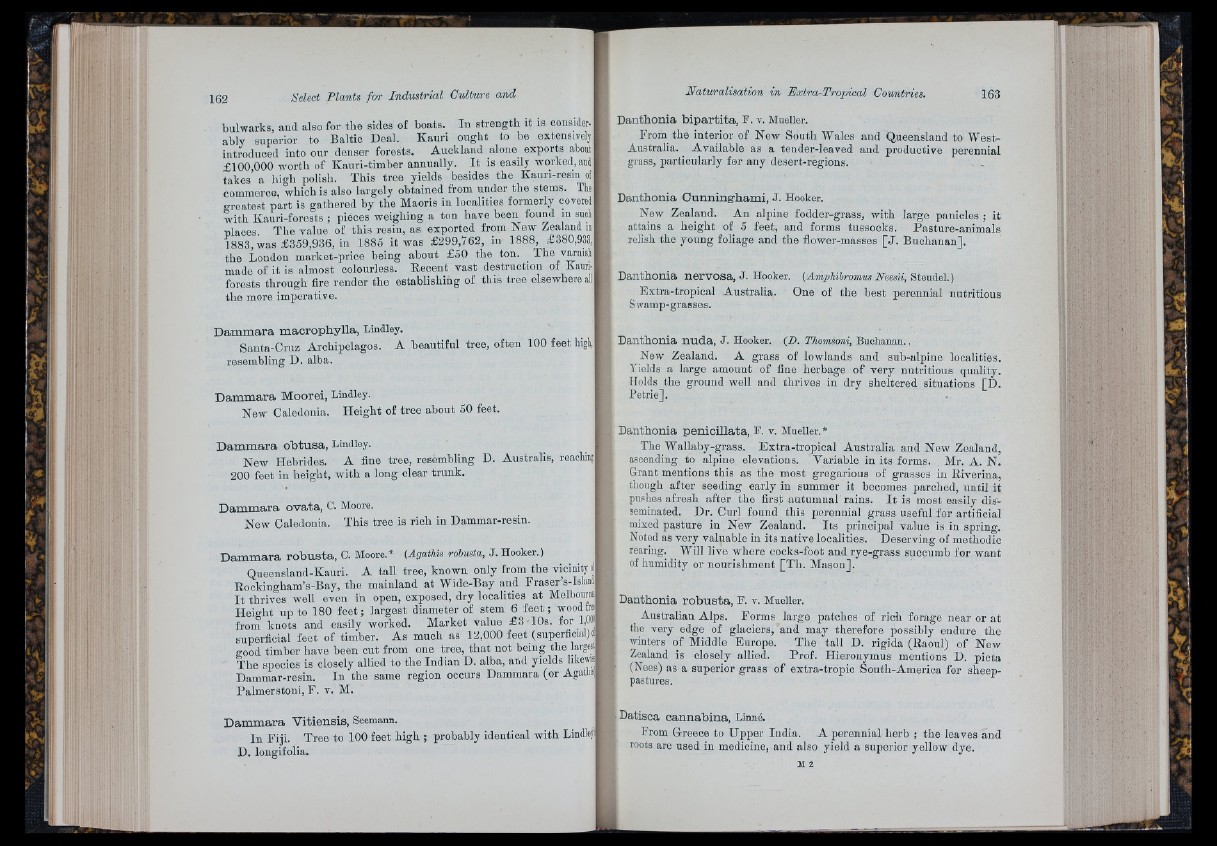
bulwarks, and also for the sides of boats. In strength it is consider-
ably superior to Baltic Deal. Kauri ought to he extensively
introduced into our denser forests. Auckland alone exports about
£100 000 worth of Kauri-timber annually. I t is easily worked, aud
takes’ a high polish. This tree yields besides the Kaim-resui ol
commerce, wliich is also largely obtained from under the stems. The
greatest part is gathered by the Maoris in localities formerly covered
with Kauri-forests ; pieces weighing a ton have been found m such
nlaoes. The value of this rosin, as exported from New Zealand it
1883, was £359,936, in 1885 it was £299,762, in 1888, £380,933,
the Loudon market-price being about £50 the ton. ^ The vanish
made of it is almost colourless. Recent vast destruction of Kaun-
forests through fire render the establishing of tliis tree elsewhere al
the more imperative.
D a m m a r a m a c r o p h y lla , Lindley.
Santa-Cruz Archipelagos. A beautiful tree, often 100 feet high,
resembling D. alba.
D am m a r a M o o re i, Lindley.
New Caledonia. Height of tree about 50 feet.
D am m a r a o b tu s a , Lindley.
New Hebrides. A fine tree, resembling D. Australis, reacliiii;
200 feet in lieight, with a long clear trunk.
D am m a r a o v a ta , C. Moore.
New Caledonia. This tree is rich in Dammar-resin.
D am m a r a r o b u s t a , c. Moore.* (AgatUs rohusta, J. Hooker.)
Queensland-Kauri. A ta ll tree, known only from the vicinity o!
Eockingham’s-Bay, the mainland at Wide-Bay and Fraser’s-Island
I t thrives well even in open, exposed, dry localities a t Melbouni
Height up to 180 fe e t; largest diameter of stem 6 fe e t; wood fra
from knots and easily worked. Market value £ 3 10s. for 1,011
superficial feet of timber. As much as 12,000 feet (superfloial)o.
good timber liave been cut from one tree, th a t not being the largesl
The species is closely allied to the Indian D. alba, and yields likewis
Dammar-resin. In the same region occurs Dammara (or Agatliii
Palmerstoni, F. v. M.
D am m a r a V itie n s is , Seemann.
In Fiji. Tree to 100 feet liigh ; probably identical with Lindley
D. longifolia.
D a n th o n ia b i p a r t i t a , F. v. Mueller.
From^ the interior of New South Wales and Queensland to West-
Australia. Available as a tender-leaved and productive perennial
grass, particularly for any desert-regions.
D a n th o n ia C u n n in g h am i, J. Hooker.
New Zealand. An alpine fodder-grass, with large panicles ; it
attains a height of 5 feet, and forms tussocks. Pasture-animals
relish the young foliage and the flower-masses [ J . Buchanan].
D a n th o n ia n e r v o s a , J. Hooker. (Amphibromus Neesii, StcnAel.)
Extra-tropical Australia. One of the best perennial nutritious
Swamp-grasses.
D a n th o n ia n u d a , J. Hooker. (A. Thomsoni, Buchanan.,
New Zealand. A grass of lowlands and sub-alpine localities.
Yields a large amount of fine herbage of very nutritious quality.
Holds the ground well and thrives in dry sheltered situations [D.
Petrie].
Danthonia p en io illa ta , F. v. Mueller. *
The Wallaby-grass. Extra-tropical Australia and New Zealand,
ascending to alpine elevations. Variable in its forms. Mr. A. N.
Grant mentions this as the most gregarious of grasses in Riverina,
though after seeding early in summer it becomes parched, until it
pushes afresh after the first autumnal rains. I t is most easily disseminated.
Dr. Curl found this perennial grass useful for artificial
mixed pasture in New Zealand. Its principal value is in spring.
Noted as very valuable iu its native localities. Deserving of methodic
rearing. Will live where cooks-foot and rye-grass succumb for want
of humidity or nourishment [T h . Mason].
Danthonia ro h u s ta , F. v. Mueller.
Australian Alps. Forms large patches of rich forage near or at
tlie very edge of glaciers, and may therefore possibly endure the
winters of Middle Europe. The tall D. rigida (Raoul) of New
Zealand is closely allied. Prof. Hieronymus mentions D. piota
(Nees) as a superior grass of extra-tropic South-America for sheep-
pastures.
Datisoa c a n n a b in a , Linné.
From Greece to Upper India. A perennial herb ; the leaves and
roots are used in medicine, and also yield a superior yellow dye.